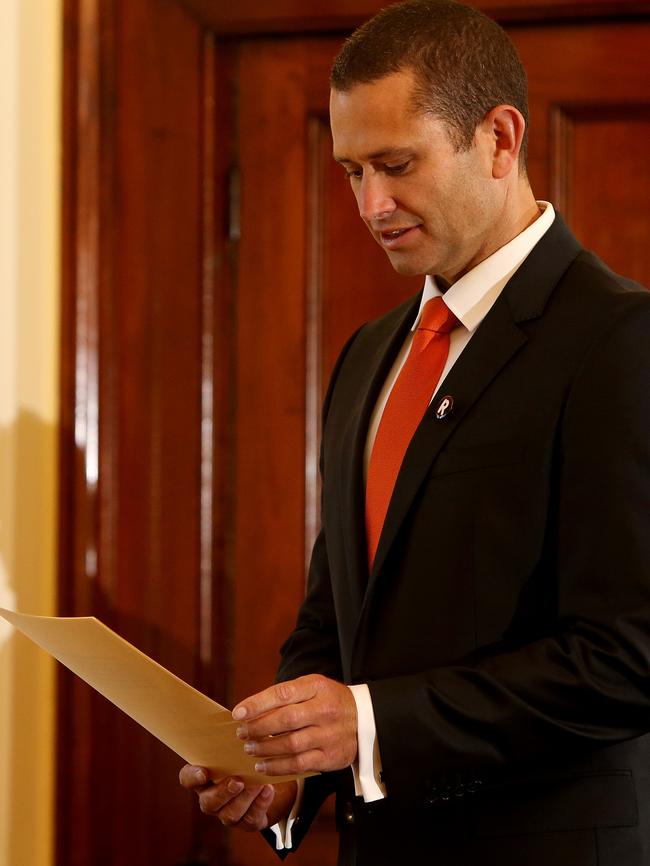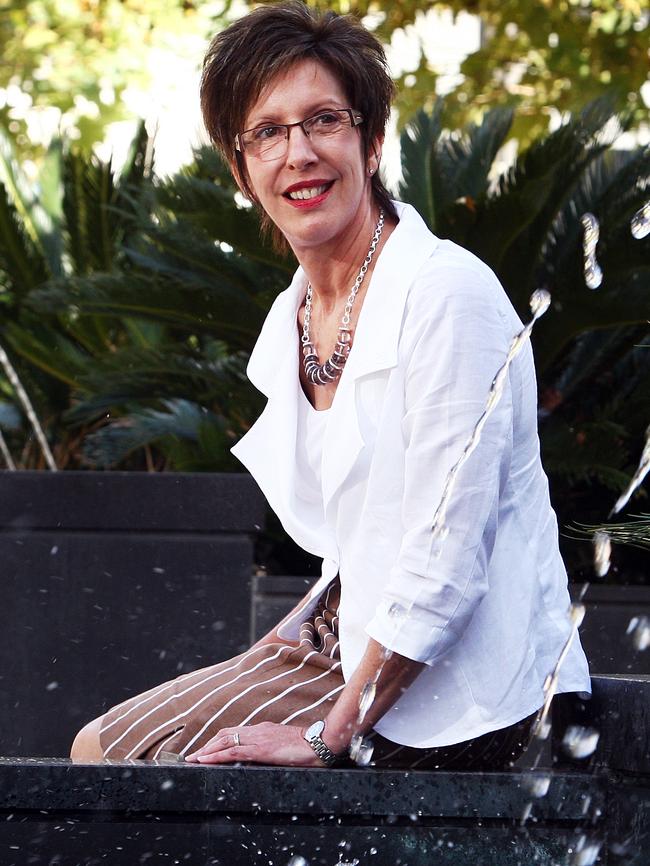The revolving doors of South Australia’s Cabinet ministers
SUCCESSIVE Cabinet reshuffles in SA has seen many portfolios handed from minister to minister. Can fresh eyes help - or does it make long-term reform impossible?

SA News
Don't miss out on the headlines from SA News. Followed categories will be added to My News.
PREMIER Jay Weatherill reshuffled his ministerial team at the beginning of this month, after the surprise resignation of Jennifer Rankine from the frontbench left the key education portfolio open.
The opportunity to again shift the ministerial puzzle pieces saw rising talent Susan Close moved to education and Kyam Maher promoted into the ministry, to take on Aboriginal Affairs.
These portfolios are among a number which have been shifted to a new pair of hands through successive reshuffles over the years.
Some argue fresh eyes can spark smart reform but critics say a rotating roster of ministers makes it impossible to carry out long-term reform.
TREASURY
A REGULAR turnover of treasurers threatens to promote short-term thinking at the expense of long-term reform and damage business confidence, a leading economic commentator says.
Prescott Securities chief economist and former Federal Treasury official Darryl Gobbett says stability in Cabinet’s most senior portfolio is critical for the public service and business sector.
After a decade of continuity in the portfolio under former deputy premier Kevin Foley, the state has now had four treasurers in almost as many years. Barring unforeseen circumstances, Treasurer Tom Koutsantonis is expected to have an unbroken run until the next election in 2018.
Mr Gobbett said it often took a long time for public servants to bring new treasurers and their staff “up to speed” on major economic issues and teach them the Budget process.
“It takes a long time,” he said. “A lot of them actually feel overwhelmed by the new role. “Even if you didn’t like Foley, at least he brought consistency to the position.
“All of a sudden, when you get another treasurer come in, he or she has got different ideas about whether the strategy should be to go for growth and in what sectors.”
Mr Gobbett said it appeared Mr Koutsantonis was intent on driving down Government spending over several years, and could only achieve that ambition with job security.
“It’s a very hard part of being a treasurer — most of the time you’re saying ‘no’,” he said.

March 2014: Tom Koutsantonis. Has background in small business and served in the mining and transport portfolios. Announced the sale of Motor Accident Commission assets and the increase to Emergency Services Levy in his first Budget.
January 2013: Jay Weatherill. Took Treasury in addition to the Premier’s role, saying it was important to focus on the economy. Recorded biggest deficit in the state’s history and oversaw a continued increase in the size of the public sector.
February 2011: Jack Snelling. Delivered two budgets before being shifted to health. Included the controversial sales of lottery and forest assets. Tried to push tax reform but plans dumped.
Since 2002: Kevin Foley. Delivered a decade of stability and returned the state’s AAA credit rating amid a boom in retail and housing activity.
EDUCATION
THE teachers’ union says the latest ministerial reshuffle was a step in the right direction but still will not deliver a singular focus on education.
Dr Susan Close became the fifth Education Minister in five years after Jennifer Rankine stepped down.
The Australian Education Union, the Opposition and some parent groups have lobbied for splitting education and child development into separate departments, so education ministers and bureaucrats are not continually swamped by Families SA scandals.
The reshuffle delivered a halfway house solution: A single department remains, but Ms Close will be shielded from the worst of Families SA’s woes by Deputy Premier John Rau, who has taken on a new “child protection reform” brief.
AEU state branch president David Smith said the constant churn of ministers “muddies the water and confuses issues”, though he praised Dr Close as someone with a “strong commitment to public education”.
Mr Smith said Mr Rau’s appointment would allow Dr Close to focus more on education instead of child abuse issues, but the situation was not ideal.
“We would still prefer that she should put all of her attention into the education of children in this state,” he said.
Preschool Directors Association of SA president Marilyn Clark said changes of minister within the same party had little impact compared with changes of government.
Ms Clark urged the State Government to continue pressing the Federal Government for a quick resolution to basic preschool funding arrangements for future years, after a prolonged standoff.
“Obviously we would (also) like to see some increases in funding around support for children with disabilities and early intervention resources,” she said.

February 2015: Dr Susan Close. Former public service executive and Adelaide University director of student services. Held Public Sector and Manufacturing, Innovation and Trade portfolios.
January 2013: Jennifer Rankine. Swamped by fallout from the Debelle Inquiry and the case of a Families SA worker accused of sexually molesting seven children.
October 2011: Grace Portolesi. Removed from portfolio in January 2013 after months of dealing with child abuse revelations in schools. Lost her seat at 2014 election.
March 2010: Jay Weatherill. Attempted to boost school autonomy and trialled CCTV and GPS in buses to protect children with disabilities. Became Premier October 2011.
2004: Jane Lomax-Smith. Introduced the controversial “super schools” policy in 2006. Lost her seat in 2010.
POLICE
SOUTH AUSTRALIA has had six Labor police ministers since 2008, but neither SA Police nor the SA Police Association wants to rate the individual office holders — and for good reason. They do not want to bite the hand that feeds them.
Both organisations declined to answer questions which went to the relationship and influence of each minister..
SA Police succinctly said: “South Australia Police maintains a professional and progressive working relationship with the Government.’’
As the police officers’ union, the SA Police Association should be vocal about conditions, which includes up-to-date law changes and the introduction of modern technology. It often is but it prefers to keep confidential its discussions with the department or the government of the day.
The incumbent commissioner runs the police department but effective policing is high cost to the community, so funding of personnel and equipment is always an issue. Legislation to meet the changing culture is also paramount and that’s where the sitting minister comes in.
March 2014: Tony Piccolo. Has been active with reviews into introducing body cameras for police, meeting a target of 300 more officers by 2018 and fending off criticism over speed camera revenue.
February 2014: John Rau. Caretaker minister before election – too short a time to make an impact.
January 2013: Michael O’Brien. Happy for police management to handle most things provided there were no political problems.
October 2011: Jennifer Rankine: Hands-on minister, which didn’t impress some.
February 2011: Kevin Foley. Supported front-line police with legislation that gave them new powers. Presided over 16 EBA pay rise.
July 2008:Michael Wright. Longest-serving minister over the period; considered effective because of his open and collaborative approach.
ABORIGINAL AFFAIRS
NEW Aboriginal Affairs and Reconciliation Minister Kyam Maher has a “great deal of work to do” to improve outcomes and earn the trust of the state’s indigenous people, advocates and MPs say.
Mr Maher took over the role from Ian Hunter, becoming the fifth minister to hold the portfolio in nine years.
Mr Hunter had faced growing pressure over issues including the management of the APY Lands and a perception that he was not engaged with Aboriginal communities.
Advocates and MPs have criticised the State Government for too regularly shunting the portfolio to a new minister, making it impossible to implement long-term plans.
Aboriginal Legal Rights Movement CEO Cheryl Axleby said Mr Maher had “a great deal of work to do”.
She said it had been “very, very difficult to get meetings” with previous ministers or officials to discuss concerns.
Ms Axleby said the new minister must focus on issues including Aboriginal children in state care, justice reforms, addressing funding cuts and the level of input Aboriginal people have in decisions.
Mr Maher said his priorities would include putting a greater focus on reconciliation and giving Aboriginal South Australians an avenue to express their concerns and ideas. “It's a bit of a stain on us ... that we don’t do better,” he said.

February 2015: Kyam Maher. Was chief of staff 2002-2006 for the late Terry Roberts when he held the portfolio. Served on the Aboriginal Lands Standing Committee.
January 2013: Ian Hunter. Legislated to gain power to suspend APY executive board and appoint an administrator.
October 2011: Paul Caica. Period of intense debate over recognising Aborigines in the state’s Constitution, rising food prices and reports of suicides on the APY Lands.
March 2010: Grace Portolesi. Launched six-year APY Lands Food Security Strategic Plan.
Since 2006: Jay Weatherill. Held the portfolio during inquiry into children on the APY Lands. Launched review of the Aboriginal Heritage Act.
HIGHER EDUCATION AND EMPLOYMENT
WITH TAFE SA haemorrhaging jobs, the Skills For All training scheme under fire and the car industry on the brink of extinction, perhaps it is little wonder employment and higher education have been such hot potatoes.
Gail Gago, the fifth minister to hold them since 2009, retained them in the reshuffle.
Australian Council for Private Education and Training state executive officer, Dr Joy de Leo, said the implementation of Skills For All might have been much smoother if there had been more stability at the ministerial level.
The subsidised training scheme has been heavily criticised for spending hundreds of millions of dollars training tens of thousands of South Australians, with limited evidence of job outcomes.
Dr de Leo said she was glad Ms Gago retained her position to oversee an expected overhaulthis year.
“(Each time ministers change) we have had to inform them of the issues from our perspective and it takes time for them to get their head around everything,” she said.
Master Builders SA chief executive John Stokes said the revolving door of ministers was a concern at both state and federal levels.

March 2014: Gail Gago. Faces the task of further reining in the spending excesses of the Skills For All program. She is expected to announce a major VET sector shake-up shortly.
January 2013: Grace Portolesi. Took up the position after being dumped from the Education Portfolio. Lost her seat of Hartley in 2014 election.
October 2011: Tom Kenyon. Made gaffes, including choosing an imported Toyota as his ministerial car.
March 2010: Jack Snelling. Provoked a backlash over his plan to remove funding
for adults seeking to finish high school.
2009: Michael O’Brien. Spent $5.7 million assisting workers sacked from the Bridgestone tyre plant to get back into work.


